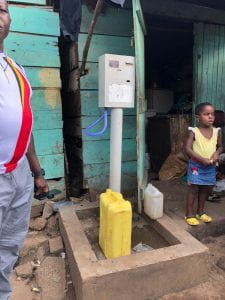First and foremost, when traveling to any country, no matter how developed, you must maintain an open mind and open heart. They must both be fully open to learning, seeing, and experiencing everything there is to offer; this includes both the wonderful experiences that can fill you with laughter and joy as well as the moments that cause your heart to break. Without opening your heart and mind there is very little growth that can occur within you. Instead there can be a hardening of negative stereotypes and an overall negative light on everything you do while abroad. I have waited to write this entry till later in the trip so that I could reflect upon what I have seen while in Uganda and write with a more informed point of view so now it is actually towards the end of our time here in country.
During our time here in Uganda we have been spending a limited part of our time within some of the different slums within the bounds of the city of Kampala. There we have been conducting an examination of the urban environment which includes capturing the location and appearances of alcohol advertisements to aid in future research on the locations of alcohol advertisements and high drinking areas within the slums/city. But why exactly are we doing this you might wonder? Why would we spend the start of our summer traveling half way across the world to Uganda to look at alcohol? Well here in Uganda there is a large part of the population below the age of 35, meaning that there is a very young population who are at high risk of alcohol usage and abuse. Along with this there are high rates of unemployment which also contributes to high rates of alcohol usage. The policies surrounding drinking and alcohol in Uganda are also outdated and hardly (if actually ever) enforced. This is actually surprising itself as they have strict policy on the selling of tobacco which is enforced at a 21+ age limit.
So, the week before we went into the slum areas to conduct the study we spent an afternoon doing a “pilot” trip to one of the areas to practice what we would be doing. It was decided that we would start at the boda boda station, walk along the street for 100m taking note of several items, then walk back to the station and continue 100m in the other direction. This would provide us with a direct overview of the area. After the initial practice it was decided that we would actually go into more of the main slum which would provide us with a better understanding of the environment which a large population lived. Where we walked was one of the main walkways for the slum and was located right on the train tracks.
Anyone who has been to a slum area or even seen pictures can imagine the buildings which make up such an area. It is a tumbling sprawl of buildings made out of all materials you can think of: metal, concrete, mud, wood, tarps, anything that can aid in the construction of a building is used. Where one building ended, another would begin. Most of the buildings did not have windows, and if they did not have a door there was instead a piece of cloth covering the entryway. There were countless shops and stands selling street foods, and dozens of bars selling the locally made alcohol out of tiny plastic bags (kind of like a little illegal adult juice pack), jugs, and even buckets. While walking down the first street we actually encountered a community water source (a photo of which is included below) to active it someone has to come a place a pre-paid card into the water pump which allows the water to be released.
Overall there was a sense of organized chaos with people running everywhere or sometimes stumbling depending on their sobriety, women standing in their doorways or sitting on mats outside selling different foods, boda bodas roaring past on the dirt street, and dozens of children running around us and walking with us through the community. The children especially were constantly laughing and grabbing for our hands, arms, cameras. They were excited to see people being in their community and being able to share it with them, and they loved selfies. By the time we were about to walk out of Namuwongo we had over 30 children around us shouting and laughing. Later we thought it a tad odd that there were no adults around them but we also discussed the possibility of a lot of these children potentially being orphans or being looked after by grandparents because their parents may have died (most likely from HIV).
It should never be easy walking through a community like this, no matter the number of times you do it. But something that is truly amazing no matter where in the world you go in the world is that in areas such as Namuwongo, it is the people who we think have the least who are the happiest. This is a lesson that we should take from the people we see and meet while abroad, that you do not have to have everything in the world to have a positive outlook on life.




